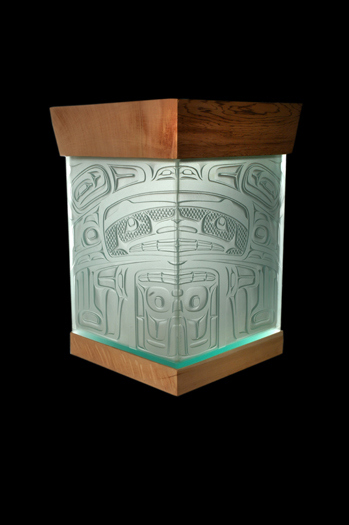House of the Mouse

House of the Mouse, 2006, Alano Edzerza (Canadian, Tahltan, b. 1981), 18 1/2 x 13 x 13 in. (47 x 33 x 33 cm), sand-blasted glass and cedar, Collection of Rodney Boleyn and Alissa Boleyn, L10.2023:16
Verbal Description
Hello, I’m Mackenzie Strong, the museum’s curatorial assistant for Decorative Arts and Design. I will be sharing a description of House of the Mouse by Alano Edzerza in Clearly Indigenous: Native Visions Reimagined in Glass.
Alano Edzerza, born in 1981, is a First Nations artist of the Tahltan Nation in Canada. He created House of the Mouse, a sand-blasted glass and cedar artwork in 2006. It is in the collection of Rodney Boleyn and Alissa Boleyn.
House of the Mouse is a three-dimensional sculpture crafted from sand-blasted glass and cedar. This vertically oriented work measures 18 and ½ inches tall, 13 inches wide, and 13 inches deep or 47 centimeters tall, 33 centimeters wide, and 33 centimeters deep. It is on view in a case with several other works, making it visible from only one vantage point. The sculpture consists of a rectangular box of tinted green glass which has a warm brown cedar base and lid. The lid is slightly wider and flared compared to the thinner, more squared-off base. The object is angled so that a corner of the box faces the viewer. This corner bisects a symmetrical design that has been sandblasted into the surface of the glass. The rounded geometric shapes that comprise the design may represent the face and body of an animal-like figure, perhaps that of the mouse in the work’s title.
Label Audio
Hello, I’m Mackenzie Strong, the museum’s curatorial assistant for Decorative Arts and Design. I will be sharing the label for House of the Mouse by Alano Edzerza in Clearly Indigenous: Native Visions Reimagined in Glass.
Alano Edzerza, born in 1981, is a First Nations artist of the Tahltan Nation in Canada. He created House of Mouse, a sand-blasted glass and cedar work, in 2006. It is in the collection of Rodney Boleyn and Alissa Boleyn.
Alano Edzerza is a member of the Tahltan Nation of Canada. Some of the Tahltan art forms, as seen in House of the Mouse, have similarities to the art and design of the Tlingit, also an Athabaskan tribe. Edzerza works with flat glass, which he shapes and layers and then sandblasts. He often sets his pieces in wood, generally cedar, to recognize that he draws inspiration for his glass boxes from designs found in traditional wood carvings.
